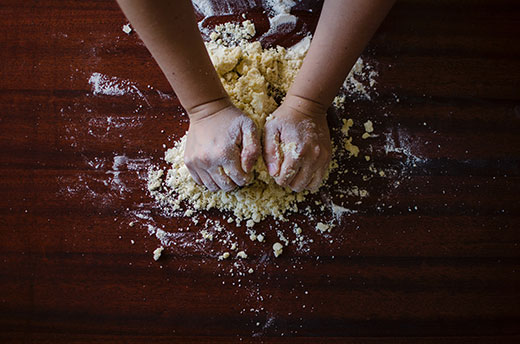
Making bread and other baked goods are among the changes Americans made while staying at home in 2020.
Nearly 1 in 3 Americans report eating more healthy during pandemic
Staying home has helped people make wiser food choices, save money
Feb. 8, 2021
MANHATTAN, Kan. – Nearly 1 in 3 Americans have said that their eating habits became more healthy during the COVID-19 pandemic, according to a study released recently by the International Food Information Council.
“That’s a good thing that has come out of this no matter what age you’re at,” said Kansas State University food scientist Karen Blakeslee. “Making changes in your diet or your eating habits to be healthier can really impact your health in the long run.”
Listen to an interview by Jeff Wichman with Karen Blakeslee on the weekly radio program, Sound Living
Blakeslee said the trend toward health got a boost by people staying home more.
“Staying home allowed consumers to pull out their recipe books and cook more at home,” she said. “Simply having the time to cook at home allowed consumers to be creative and try new cooking techniques, or dust off an appliance that was rarely used.”
Consumers also have been more likely to try mail-order kits or subscribe to a fresh food service so that they didn’t have to go to the grocery store, according to Blakeslee.
“Time in the kitchen also allowed time for more baking, and many are going to continue baking (after the pandemic has passed),” she said, noting that yeast was among the products that became difficult to find in grocery stores.
“There are people who used to say, ‘I’d like to (bake) some day.’ Well, they got their chance, and many of them decided to learn how to bake yeast bread. It’s a science in itself; it takes some practice to do that successfully.”
Also contributing to healthier eating: Blakeslee notes that 30% of people reported paying closer attention to nutrition facts labels, which now include important information on sugar and sodium content in foods, as well as vitamin D, calcium, iron, potassium and more.
“There is a lot of really good information on there that can help you make healthy food choices,” Blakeslee said.
Blakeslee also noted some ways in which consumers can continue saving money once the pandemic is over, including:
- “Make the choice to eat outside the home only on a special occasion.” Many consumers saved money eating at home while the choices to eat outside of the home were limited.
- When shopping for groceries, choose store brands instead of popular name brands.
- Shop the pantry before heading to the grocery store to prevent unnecessary food purchases.
Blakeslee, who is also coordinator of K-State’s Rapid Response Center for food science, publishes a monthly newsletter, called You Asked It!, that addresses many issues related to food science and safety.
More information on food safety also is available online from K-State Research and Extension.

